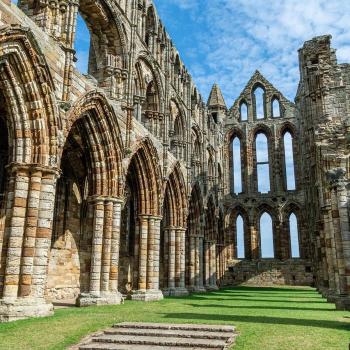RACHAEL’S QUESTION:
I’ve heard of Yazidis but don’t know much about them. What are some basics of their beliefs?
THE RELIGION GUY’S ANSWER:
The genocidal effort by the “Islamic State” (I.S.) to exterminate devotees of this small Kurdish religion centered in mountainous northern Iraq is a great moral outrage of the era. The opponents’ bloodthirsty zeal exceeds even the persecution, enslavement, exile, and murder I.S. has visited upon Christians.
With Mosul as the current focus of coalition combat to expel I.S., note that just 36 miles northeast of that metropolis lies Lalish, the holy city of the Yazidi (also transliterated as Yezidi, Azidi, Zedi, or Izdi). It’s the site of the major shrine and pilgrimage destination, the tomb of 12th Century Sheikh Adi ibn Musafir, venerated as the founder (or co-founder) of the faith.
Yazidism is also in the news because refugee Nadia Murad Bassee has emerged internationally as the Yazidi voice for thousands of fellow young women subjected to kidnapping, sexual trafficking and rape at the hands of I.S. In recent weeks she was awarded the Vaclav Havel Human Rights Prize, and shared the Andrei Sakharov Prize for Freedom of Thought with another Yazidi, Lamiya Aji Bashar. (Web: www.nadia-murad.com).
Such hate has persisted over centuries and Yazidi annals count 72 previous waves of persecution. Muslim extremists find the Yazidis especially repellent and threatening. They are considered apostates from true Islam and thus deserving of death, and also as supposed “devil worshippers.”
In fact, this is a unique and lavishly syncretistic creed. Sheikh Adi, a Sufi mystic, is thought to have been an orthodox Muslim and Yazidism does draw some elements from that religion, for instance the animal sacrifices, multiple daily prayer times, and the ban on pork. However, scholars say Yazidism draws from ancient roots in pre-Islamic tribal faiths, alongside aspects of Judaism (e.g. circumcision), the Nestorian branch of Christianity (baptism), Hinduism (caste lines, a cycle of reincarnation to purify the soul), and ancient Mithraist and Zoroastrian influences.
The Yazidis’ own self-understanding holds that theirs is humanity’s original and oldest religion. By the reckoning at Yeziditruth.org, the religious calendar traces back 6,764 years, a millennium earlier than the Jewish calendar. The tradition teaches that Yazidis are a specially chosen people created by God as the offspring of Adam alone, while all other humans stem from Adam and Eve.
The Encyclopaedia Brittanica says Yazidis “seek to keep themselves segregated from the people among whom they live.” One must be born into the faith because it does not welcome converts. Segregation does not mean hostility, however. Yazidis have helped persecuted Christians in the past, just as Christians have helped Yazidis during their recent peril. Like other religions, Yazidism opposes intermarriage outside the faith, but in addition forbids marriage across its own caste lines.
The emphasis on separation from outside influences fostered till recently a strong taboo against learning to read and write. Consequently, traditions were preserved through oral transmission. That, combined with secrecy (also practiced by the Mideast’s Druze), makes it difficult for scholars to be absolute about Yazidi history. There are also questions about the authenticity of modern written versions of the Yazidi scriptures, the “Book of Revelation” and the “Black Book.”
Reliance on oral tradition also leads to local variations in the complex purity requirements that characterize Yazidism. For example, all believers shun the eating of lettuce as evil, but some or many abhor other vegetables as well. Another notable taboo forbids the wearing of blue clothing. Again, oral tradition means the origin and explanation for such bans is obscure.
Even the Yazidi label is debated. It could stem from an ancient Persian term for God-worshippers. Or else it indicates descent from supporters of Islam’s second Umayyad caliph, Yazid I (645-683 C.E.), who is despised by Shi’a Islam as the ruler under whom the Prophet Muhammad’s revered grandson Husayn was martyred.
Yazidis insist that the “devil worshipper” claim misunderstands their theology. The religion believes the one supreme God refused involvement with the creation and delegated control to seven divine beings among whom Malak Ta’us (the “Peacock Angel”) dominates. These angels are reverenced in the form of metal images in festivals and home shrines. Confusion occurs because Malak Ta’us was a fallen angel, like Islam’s Satan. However, he repented, was pardoned, and is not the devil. Yazidis are forbidden to utter the name “Satan” or any words with similar sound.
Perhaps half of the Yazidis live in the Kurdish heartland, with a diaspora in southeastern Turkey; the region around war-torn Aleppo, Syria; Armenia; Georgia; and Germany, with tiny groups elsewhere. Population claims run as a high as a million but others think 200,000 is likely — and probably less than that with the recent slaughter. Iraq’s Kurdistan sector is the home of the Yazidis’ hereditary temporal leader (“Mir”), Tahsin Said Ali Beg, and their spiritual leader, the “Baba Sheikh,” currently Sheikh Kato.












